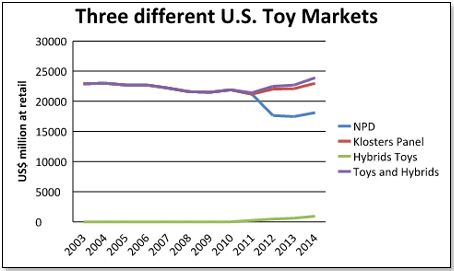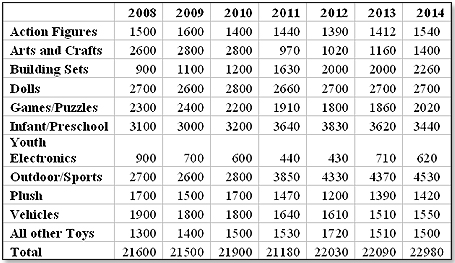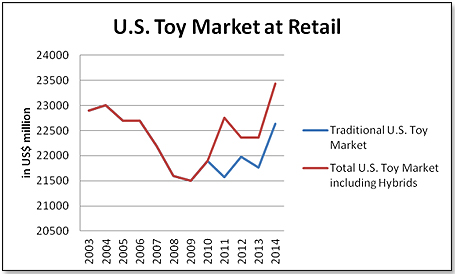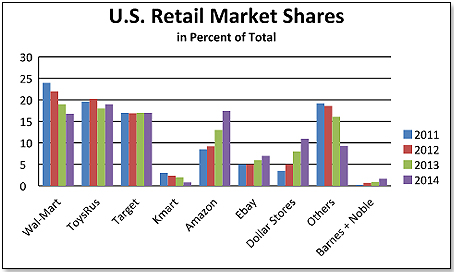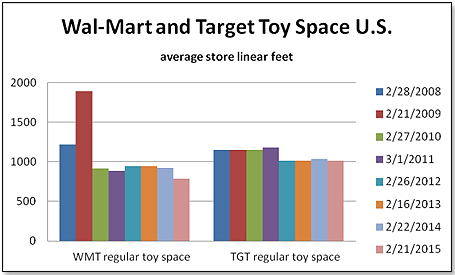
December 14, 2025

March 2015 | Vol. XIV - No. 3
The Current State of the U.S. Toy Space
The US Toy Industry is flourishing - though not by all metrics.
Some, particularly those not too familiar with the U.S. toy market, are confused by the fact that there are three very distinctly different ways of assessing it. One is NPD, still considered the gold standard by some, who say that the traditional toy market in the U.S. is at retail worth US$ 18.11 billion. Then there are those, including the Klosters Retailer Panel, who say that it is in fact about 26% higher at US$ 22.98 billion. And finally, there are those that add the toy sales of the Hybrids – Skylanders, Disney Infinity and Amiibo - to this latter total since they believe, and the national buyers concur, that the Hybrids are in fact part of the toy space and not of the Video Game market as NPD asserts.
The difference between the three is best illustrated by a historical chart:
Source: Klosters Retailer Panel
Something interesting happened in 2012. According to NPD, the toy market tanked by 20%! Had this in fact been the case, masses of toy manufacturers would have gone out of business and a couple of CEOs would have unfurled their golden parachutes. This, fortunately, did not occur and the explanation was and is simple. NPD in their wisdom elected to ignore from that point onwards the 20% of the toy market not covered by their Retail Tracking Service. The Klosters Retailer Panel, however, decided not to follow this course and to continue to report 100% of the traditional toy market.
Given this basis, the individual toy categories performed as follows (in US$ million, at retail):
Source: Klosters Retailer Panel
The major winners in 2014, in Dollar terms, were the Building category, followed by Arts and Crafts. The former was driven by one company only – Lego – who continued to totally dominate it. The second, Arts and Crafts, benefited from two aspects. One was the economy, which made Activity Kits attractive because of their price points; the other, the fact that parents – rightly – believe that arts and crafts endeavours are beneficial to the child in terms of skill development.
The major loser was Preschool, for two reasons. The first was the economy, which over the past couple of years has forced families on restricted budgets to make choices. One of these choices was to go down the price scale or to substitute when buying toys for the kids below four years in age. The second factor was the inroads made by the hybrids, particularly Infinity and of late also Amiibo, who began to take over market share from traditional preschool toys.
While it is common practice to decry the U.S. toy space as one where nothing ever happens except stagnation, the reality is quite different. For one, whilst the traditional toy market has zigzagged between US$ 21 billion and US$ 22 billion since 2003, this is not a true reflection of the situation for two reasons. One is that whilst sales in US Dollars have indeed stayed level for more than ten years, sales in units have in fact increased at a yearly rate of about 2%. Migration of manufacturing from the U.S. and Europe to China accounts for the discrepancy. By moving production to the Middle Kingdom, costs were significantly reduced and this allowed prices to drift South, which in turn led to depressed Dollar sales. This trend has come to an end and the turn-around started already last year.
The other is that the traditional toy market numbers totally ignore the impact of the hybrids – the Skylanders, Infinity and Amiibo. This is due to the fact that NPD defines these brands as part of the video game space even though about 85% of their sales are in toy figures, which directly compete with Action Figures and Preschool toys. By adding their sales back into the toy revenue numbers, we get a greatly different picture, as demonstrated by the chart below:
Source: Klosters Retailer Panel
So, in short, the toy market is doing pretty well. This does not mean that it does not have its challenges. It is a large, obviously growing, and extremely competitive market place and there are, as you would expect, winners and losers.
This is obvious if you look at the toy market shares of the leading retailers:
Source: Klosters Retailer Panel
The big loser is Wal-Mart, and its decline tells us that pricing is not the sole factor determining market share changes. Wal-Mart is in fact pretty competitive, but it is losing its consumers for a totally different reason – shopping there has become an ordeal. Their shelves are half empty during the day; most of their cash registers are not attended when long lines of very patient customers are trying to pay for their purchases; floors are unswept and toilets are a disgrace. As a result, people have begun to vote with their feet. There are now indications that Doug McMillon, the new Wal-Mart CEO and the first merchandising executive to run the company since Sam Walton, has recognized the fact that changes have to be made, however painful, and that paying their shop floor people a living wage is a good start.
The “Others” are also losers – mainly Mom-and-Pop stores and opportunistic entrants such as the Walgreens and Supermarkets of this world – but this picture is a little misleading. A significant portion of their business is being done online, mainly via Amazon, and their sales show up in the rapidly increasing market share recorded for this retailer.
Another winner is Barnes + Noble, which is slowly emerging as a factor in the toy space. They are still small, at an estimated 1.5% market share, but this is still nearly double of what they had at the end of 2013.
The real winners are the Dollar Stores – their stores are neat and well staffed, their prices are extremely low and their toys may often be close-out, but you would not know this by looking at them.
ToysRUs has recaptured some of the market share lost recently and has begun to further sharpen their competitive posture, at least in the toy space. However, indications are that the gains made in the first nine months of 2014 were, to a large degree, again lost in the fourth quarter.
The three leading retailers – Target, ToysRUs and Wal-Mart – are not immune to the vicissitudes affecting the toy space and they are reacting to them, but each slightly differently. In the case of Wal-Mart, toys are a political football and every new CEO kicks it into a slightly different direction – either viewing it as a traffic driver opportunity or as a second-rate use of space.
Bill Simon, the last CEO Wal-Mart USA, saw it as the latter and toy area hygiene began to suffer. Greg Foran is said to be of the traffic-driver school of thought and, if so, he has his work cut out for himself. In any event, the store area devoted to toys reached a peak in 2008 and then began to fall of a cliff. While there has been a modest resurgence since 2012, I do not see a major expansion in the toy space until the company has got its act together and to a point where toy shelves are consistently filled and maintained.
As for Target, their toy space has stayed pretty even. However, I also hear that there is an ongoing conversation on the senior level at Target about the significance of toys versus baby products and I believe that there is the suggestion that increasing baby product space at the expense of toys should be considered for three reasons. One is that a strong baby product presence will over time also benefit toys in that the expectant or new mothers who come to the store to buy pampers will eventually return to also buy the toys for the little guys. The second is that the overall gross margin on baby products tends to be somewhat better than on toys. And the third, and perhaps most important, is that ToysRUs is doing badly in the category and hence could present a competitive opening for Target.
This is how Wal-Mart’s and Target’s toy space looked during the same week over the past seven years:
ToysRUs is slowly reducing their overall toy space in the context of their move from traditional TRU stores to Side-By-Side [SBS] stores. The difference between the two is in their space allocation. The traditional store devotes about 60% to toys, 20% to Babies, 15% to Electronics and 5% to other such as service desks, check-out counters, toilets et. In the Side-by-Side stores, toys are reduced to 40%, Babies are upped to 40% and the allocation for remainder stays the same. At this time, there are 214 Side-by-Side stores in the U.S. out of a total of 878 stores. However the conversion rate from regular stores to SBS, which tended to be around 40 per year, fell to a mere 3 between August 2013 and 2014 which suggests a marked slow-down. Incidentally, the number of pure BRU stores declined in 2014 by 5 stores to 230 stores. At the same time, TRU reports that its Juvenile Products sector is not doing particularly well, and there may well be a connection between this and their slow-down in conversions.
This very tough competitive environment is also leaving scars on manufacturers and this is the primary reason why you have seen so many small and not-so-small companies being bought by larger competitors in 2014 – most notably Mega acquired by Mattel, Meccano by Spinmaster, Pressman by Goliath, Brio by Ravensburger and Mojang of Minecraft fame being swallowed by Microsoft. The first four are very predictable moves by toy makers trying to enter a new toy category. The last one, Mojang, is very interesting. Ostensibly bought for their video game business, the company also has a very viable toy business and very solid licensees – Lego, Mattel, Jazwares and ToysRUs. Does this mean that Microsoft will actively enter the toy space just as Namco Bandai has done, or will they simply let their current licensees get on with it and be satisfied with whatever license royalties they can get?
The reasons that led to the number of acquisitions last year also led to a number of changes in the license line-up. Toy licenses are becoming increasingly important in the toy space and now account for more than 30% of all toy sales in the United States. In 2014, Disney’s Frozen became the most important toy license ever and is expected to dominate the Doll space also this year. Hence the decision by Disney to transfer the entire Princess Doll license, including Frozen, from Mattel to Hasbro effective 2016 shook the industry to its core. If Disney can move the top Doll license from the top Doll manufacturer to the top Action Figure manufacturer who has only a modest Girl business then nothing else can be taken for granted in the toy license universe. However, Hasbro also got a few haircuts, albeit lesser ones, last year. The company lost the Care Bear license, which they have held since 1991 when they bought Kenner Products, to Just Play; and the Strawberry Shortcake license, held since 2009, to Bridge Direct.
As you can see, the people who decry the U.S. toy space as one where nothing ever happens except stagnation need to wake up and smell the coffee.
Copyright © 2025 TDmonthly®, a division of TOYDIRECTORY.com®,
Inc.



